Reading: Old Values vs. New Values
Old Values vs. New Values
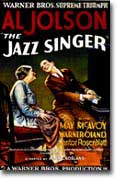
"In every living soul, a spirit cries for expression — perhaps this plaintive, wailing song of Jazz is, after all, the misunderstood utterance of a prayer." --text of the opening title card from The Jazz Singer, 1927, Hollywood's first feature-length "talkie."
Not all Americans embraced the new way of life. Many saw the United States as a civilization in decline. The original purpose of the Puritan city upon a hill seemed to be slipping away in the pursuit of materialism and self-gratification. The morals of the Victorian Age were forgotten in the age of Freud and the flapper. Immigrants brought new cultures, religions, and languages to the increasingly complex American mosaic. The success of the BOLSHEVIK REVOLUTION brought a widespread suspicion of socialists, radicals, and labor unions. There were those in America who clung tenaciously to the values of the past. They would not give up without a fight.
The first group to feel the heat were suspected Socialists. The wave of postwar strikes touched off an anti-labor sentiment across America. Fears fueled by the Russian Revolution touched off a witch hunt for potential threats to national security. Immigrants, whose numbers had been transmuting the American ethnic fabric, became targets for intolerance. Ethnic purists succeeded at slamming the open door for immigrants shut. Hate groups such as the Ku Klux Klan gained in popularity as working-class Americans took aim at African Americans, immigrants, Catholics, and Jews. The churches of America were similarly torn by the struggle between old and new. Modernists reconciled the theories of Charles Darwin with scripture, while fundamentalists persisted with a strict interpretation of creation theory.
Throughout the struggle, America's political leadership remained remarkably aloof. The White House was occupied by the most conservative Presidents in a generation during the decade of change. Warren Harding, Calvin Coolidge, and Herbert Hoover seemed content with the status quo, and delegated much of the decision-making to Congress and key Cabinet members. Businesses took advantage of the laissez faire approach.
By the end of the decade, America was on the brink of something special. An industrial revolution was now complete. The United States had proven itself as a global power in acquiring an empire and intervening in the First World War, yet lacked the physical destruction of the conflict that plagued the European continent. The standard of living was rising faster than anywhere in the world. Indeed, when Herbert Hoover took office, he predicted that America would soon see the end of poverty. No one predicted the sheer calamity that was so soon to follow.
The Red Scare
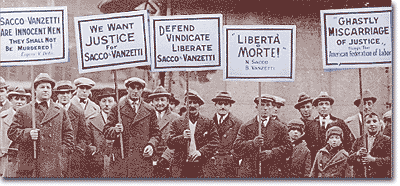
The conviction of anarchists Nicola Sacco and Bartolomeo Vanzetti sparked protests throughout the world.
World War I was over, but the hysteria lingered. The Eastern front had not gone well for Russia. The pressures of their losing effort forced the Russian czar to abdicate. The new government had not fared much better. Finally in November 1917, LENIN led a successful revolution of the Bolshevik workers. The ideas of Karl Marx had been known since 1848, but nowhere in the world until now had a successful communist revolution occurred. Once the war against Germany was over, the Western powers focused their energies at restoring CZAR NICHOLAS. Even the United States sent troops to Russia hoping the WHITE RUSSIANS could oust the communist REDS. All this effort was in vain. The Bolsheviks murdered the entire royal family and slowly secured control of the entire nation.
The Communist Party Forms
Back in the United States, veterans were returning home. Workers who avoided striking during the war were now demanding wage increases to keep pace with spiraling inflation. Over 3,300 postwar strikes swept the land. A small group of radicals formed the COMMUNIST LABOR PARTY in 1919. Progressive and conservative Americans believed that labor activism was a menace to American society and must be squelched. The hatchetman against American radicals was President Wilson's Attorney General, A. MITCHELL PALMER. Palmer was determined that no Bolshevik Revolution would happen in the United States.
The Sacco-Vanzetti Case
On April 15, 1921, two employees of a shoe warehouse in South Braintree, Massachusetts, were murdered during a robbery. The police investigating the crime arrested two Italian immigrants named NICOLA SACCO AND BARTOLOMEO VANZETTI.
Sacco and Vanzetti maintained their innocence, but they already had a strike against them: they were ANARCHISTS and socialists. Just a little over two weeks after their arrest, they were found guilty.
Many people, particularly fellow socialists, protested the verdict, saying the two men were convicted more on political and ethnic prejudice than on any real evidence. Indeed, four years later, another man said he had committed the crime with a local gang.
Despite appeals, Sacco and Vanzetti were never granted a retrial. When they were sentenced to death on April 9, 1927, protests erupted around the country. But to no avail — the men were executed on Aug. 23, 1927. They claimed they were innocent until the moment of their deaths.
Scholars still debate the guilt and innocence of Sacco and Vanzetti, but there is little question that the trial was biased against them.
Palmer's Efforts
From 1919 to 1920, Palmer conducted a series of raids on individuals he believed were dangerous to American security. He deported 249 RUSSIAN IMMIGRANTS without just cause. The so-called "SOVIET ARK" was sent back to Mother Russia. With Palmer's sponsorship, the Federal Bureau of Investigation was created under the leadership of J. Edgar Hoover. In January of 1920, federal agents broke into the homes of suspected anarchists without search warrants, jailed labor leaders, and held about 5,000 citizens without respecting their right to legal counsel. Palmer felt that American civil liberties were less important than rooting out potential wrongdoers. Eventually most of the detainees were released, but some were deported.
The climate set by Palmer and Hoover could not be contained. Still agitated by wartime propaganda, members of the American public took matters into their own hands.
AMERICAN LEGIONNAIRES in CENTRALIA, WASHINGTON attacked members of the Wobblies. Twelve radicals were arrested; one of them was beaten, castrated, and then shot. The New York State Legislature expelled five Socialist representatives from their ranks. Twenty-eight states banned the public display of red flags. It seemed as though the witch hunt would never end. Responsible Americans began to speak out against Palmer's raids and demand that American civil liberties be respected. By the summer of 1920, the worst of the furor had subsided.
The Monkey Trial
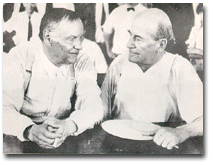
Legendary defense lawyer Clarence Darrow faces off against William Jennings Bryan in the Dayton, Tennessee trial of schoolteacher John Scopes. Bryan died in Dayton five days after the trial ended.
When Darwin announced his theory that humans had descended from apes, he sent shock waves through the Western world.
In the years that followed his 1859 declaration, America's churches hotly debated whether to accept the findings of modern science or continue to follow the teachings of ancient scripture. By the 1920s, most of the urban churches of America had been able to reconcile Darwin's theory with the Bible, but rural preachers preferred a stricter interpretation.
Amid the dizzying changes brought by the roaring decade, religious fundamentalists saw the Bible as the only salvation from a materialistic civilization in decline.
Darwin Banned
In 1925, the Tennessee legislature passed the BUTLER LAW, which forbade the teaching of Darwin's theory of evolution in any public school or university. Other Southern states followed suit.
The Butler Law
OF THE
STATE OF TENNESSEE
PASSED BY THE
SIXTY-FOURTH GENERAL ASSEMBLY
1925
________
CHAPTER NO. 27
House Bill No. 185
(By Mr. Butler)AN ACT prohibiting the teaching of the Evolution Theory in all the Universities, Normals and all other public schools of Tennessee, which are supported in whole or in part by the public school funds of the State, and to provide penalties for the violations thereof.
Section 1. Be it enacted by the General Assembly of the State of Tennessee, That it shall be unlawful for any teacher in any of the Universities, Normals and all other public schools of the State which are supported in whole or in part by the public school funds of the State, to teach any theory that denies the story of the Divine Creation of man as taught in the Bible, and to teach instead that man has descended from a lower order of animals.
Section 2. Be it further enacted, That any teacher found guilty of the violation of this Act, Shall be guilty of a misdemeanor and upon conviction, shall be fined not less than One Hundred $ (100.00) Dollars nor more than Five Hundred ($ 500.00) Dollars for each offense.
Section 3. Be it further enacted,That this Act take effect from and after its passage, the public welfare requiring it.
Passed March 13, 1925
W.F. Barry,
Speaker of the House of Representatives
L.D. Hill,
Speaker of the Senate
Approved March 21, 1925.
Austin Peay,
Governor.
The AMERICAN CIVIL LIBERTIES UNION led the charge of evolution's supporters. It offered to fund the legal defense of any Tennessee teacher willing to fight the law in court. Another showdown between modernity and tradition was unfolding.
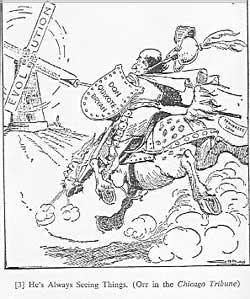
This political cartoon appeared during the Scopes monkey trial. Bryan is portrayed as Don Quixote, tilting at the windmill of evolution. The caption reads: "He's Always Seeing Things."
The man who accepted the challenge was JOHN T. SCOPES, a science teacher and football coach in Dayton, Tennessee. In the spring of 1925, he walked into his classroom and read, from Dayton's Tennessee-approved textbook HUNTER'S CIVIC BIOLOGY,part of a chapter on the evolution of humankind and Darwin's theory of natural selection. His arrest soon followed, and a trial date was set.
Darrow versus Bryan
Representing Scopes was the famed trial lawyer CLARENCE DARROW. Slick and sophisticated, Darrow epitomized the urban society in which he lived.
The prosecution was led by William Jennings Bryan, three-time presidential candidate and former secretary of state. The "Great Commoner" was the perfect representative of the rural values he dedicated his life to defend.
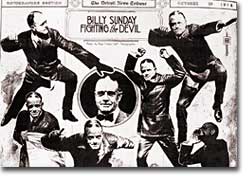
Although Fundamentalist minister Billy Sunday drew thousands of listeners to his radio program, he was also well known for his flamboyant on-stage style that included wild-eyed denunciations of alcohol and its users.
Bryan was a Christian who lobbied for a constitutional amendment banning the teaching of evolution throughout the nation.
A Media Circus — with Monkeys
The trial turned into a media circus. When the case was opened on July 14, journalists from across the land descended upon the mountain hamlet of Dayton. Preachers and fortune seekers filled the streets. Entrepreneurs sold everything from food to Bibles to stuffed monkeys. The trial became the first ever to be broadcast on radio.
Scopes himself played a rather small role in the case: the trial was reduced to a verbal contest between Darrow and Bryan. When Judge John Raulston refused to admit expert testimony on the validity of evolutionary theory, Darrow lost his best defense.
He decided that if he was not permitted to validate Darwin, his best shot was to attack the literal interpretation of the Bible. The climax of the trial came when Darrow asked Bryan to take the stand as an expert on the Bible. Darrow hammered Bryan with tough questions on his strict acceptance of several Bible's stories from the creation of Eve from Adam's rib to the swallowing of Jonah by a whale.
In the following famous excerpt from the trial transcript, Darrow questions Bryan about the flood described in the Bible's book of Genesis.
|
DARROW: But what do you think that the Bible itself says? Do you know how that estimate (of the year the flood occurred) was arrived at? BRYAN: I never made a calculation. DARROW: A calculation from what? BRYAN: I could not say. DARROW: From the generations of man? BRYAN: I would not want to say that. DARROW: What do you think? BRYAN: I could not say. DARROW: From the generations of man? BRYAN: I would not want to say that. DARROW: What do you think? BRYAN: I do not think about things I don't think about. DARROW: Do you think about things you do think about? BRYAN: Well, sometimes. |
||
Who Made Who Look Like a Monkey?
While on the witness stand, William Jennings Bryan frustrated Darrow by not directly answering the defense attorney's questions. Bryan was a Christian, but he did not necessarily interpret the Bible literally. He would not give in, however, to Darrow on the subject of miracles. Bryan believed that miracles happen, though he could not explain how.
The "Great Commoner" felt it important for an articulate defender of the Bible to speak on its behalf. At one point in the testimony, Bryan claimed that the defense had "no other purpose than ridiculing every Christian who believes in the Bible."
Bryan was not opposed to science. He was well regarded in some scientific cricles and belonged to several national science organizations.
Intolerance
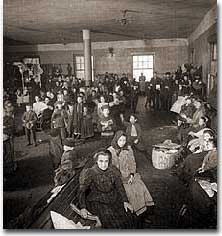
As people from other nations began to pour into the United States, some Americans began to resent their presence and blame them for economic and social problems
Sometimes the battle got ugly. Old versus new was not a conscious topic to be discussed calmly at the nation's dinner tables. In an effort to preserve so-called true American values, the forces against change sometimes displayed intolerance ranging from restrictive legislation to outright violence. Immigrants from areas outside Northern and Western Europe became targets of narrow-mindedness. African Americans faced new threats from a resurgent Ku Klux Klan. Socialists, anarchists, and atheists beware! The message was simple and clear. Conform or else.
Restricting Immigration
Since the 1880s, America's shores were flooded with immigrants primarily from Southern and Eastern Europe. The old nativist arguments grew louder in the first two decades of the 20th century. Critics of an open immigration policy cried that America's racial stock was being overrun by undesirable ethnicities. Protestant fundamentalists worried as the numbers of Jewish and Catholic Americans grew larger. Labor leaders claimed that immigration lowered wages. As a result, Congress slowly built walls against the newcomers. The first line of defense was a literacy test, passed in 1917. The results were not as encouraging as the nativists had hoped. About 1.25 million immigrants still entered America in the first two years of the twenties. An outright cap on immigrant numbers was enacted in 1921. Ethnic nationalists claimed that these conditions favored Southern and Eastern immigrants too favorably. The result was the NATIONAL ORIGINS ACT OF 1924. This law based admission to America on nationality. Immigrants from Northern and Western Europe were granted higher quotas than from other parts of the world. Asian immigration was banned completely. As a sign of pan-Americanism, there were no restrictions placed on immigrants from the western hemisphere.
Resurgence of the KKK
By 1915, the KU KLUX KLAN was almost dead. WILLIAM SIMMONS of Atlanta, a history teacher at Lanier College, summoned a secret gathering on STONE MOUNTAIN on Thanksgiving Day. As the sun set, the participants massed around a burning cross and pledged once again to reassert white supremacy. The Klan grew slowly, boasting only about five thousand members in 1920. That year, ELIZABETH TYLER and EDWARD Y. CLARKE used their professional fundraising experience to boost the Klan's numbers. They raised membership dues and sold a great variety of Klan merchandise, including the infamous hoods and robes. Simmons is credited with much of the Klan terminology. Local chapters were called KLAVERNS, songs were called Klodes, and the leader was called the IMPERIAL WIZARD. By the middle of the decade there were an estimated 5 million Klansmen, with a significant women's auxiliary. This new Klan was national, particularly strong in the Midwest and South but powerful as far west as Oregon. The targets of this group went beyond African Americans. Catholics, Jews, and "non-Nordic" immigrants were victimized by the new reign of terror. Toward the end of the decade, corruption and sex scandals among the national leadership discredited the high and mighty message the Klan was trying to promote, and membership numbers sharply dropped.
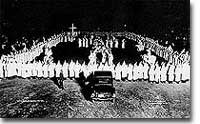
Membership in the white supremacist group the Ku Klux Klan peaked in 1924. Here, the Klan holds a rally in Williamson, West Virginia
"Back to Africa" Movement
The environment of intolerance and a new KKK prompted a drastic response byMARCUS GARVEY. Garvey believed that equality for African Americans could never be achieved in the United States. He formed the UNITED NEGRO IMPROVEMENT ASSOCIATION to promote economic cooperation among black businesses. Garvey made fiery speeches and created uniforms and flags to symbolize a new black pride. The ultimate goal for blacks across the world should be to return to the "Motherland." Only in Africa could a strong nation dedicated to promotion of black culture flourish. After amassing about 80,000 followers, Garvey founded the Black Star Steamship Company to begin transporting African Americans "BACK TO AFRICA." Closely watched by government officials, Garvey was convicted of mail fraud in 1923 and deported to Jamaica.
Sacco and Vanzetti Trial
The INTOLERANCE of the decade is embodied in the murder trial of Nicola Sacco and Bartolomeo Vanzetti. These two self-avowed anarchists and atheists were arrested in April 1920 for two Massachusetts murders. From the start, it was clear their trial was not about the murders, but about their backgrounds and beliefs. The judge violated all semblance of impartiality by criticizing their political views in court. Their guilt or innocence remains uncertain, and the circumstantial evidence on which they were convicted was murky. The jury found them guilty, and after six years of delay, Sacco and Vanzetti were silenced permanently by the electric chair.
Books and Movies
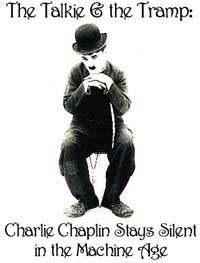
Charlie Chaplin, whose slapstick comedy made him a superstar of early films
They were called the LOST GENERATION. America's most talented writers of the 1920s were completely disillusioned by the world and alienated by the changes in modern America. The ghastly horrors of trench warfare were a testament to human inhumanity. The ability of the human race to destroy itself had never been more evident. The materialism sparked by the Roaring Twenties left many intellectuals empty. Surely there was more to life than middle-class conformity, they pined. Intolerance toward immigrants and socialists led many writers to see America as grossly provincial. Thus the literature of the decade was that of disaffection and withdrawal, and many of America's greatest talents expatriated to Europe in despair.
The Writers
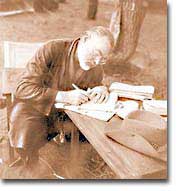
Typical of the writing of the age were the desolate landscapes of Ernest Hemingway
F. SCOTT FITZGERALD wrote about the excesses of the JAZZ AGE. He and his wife ZELDAoperated among the social elite in New York, Paris, and on the French Riviera. THE GREAT GATSBY, his most famous novel, highlights the opulence of American materialism while harshly criticizing its morality. ERNEST HEMINGWAY wrote of disillusioned youths wandering Europe in the wake of World War I in search of meaning in THE SUN ALSO RISES.T.S. ELIOT commented on the emptiness of American life in his epic poem THE WASTE LAND. American theater earned worldwide acclaim in the 1920s. The foremost playwright of this newly respected American genre was EUGENE O'NEILL, noted for DESIRE UNDER THE ELMS and A LONG DAY'S JOURNEY INTO NIGHT. The sharpest critic of American middle-class lifestyle was SINCLAIR LEWIS. In MAIN STREET, he takes aim on small-town American life. BABBITT denounced the emptiness of middle-class life in the city. After a string of successful novels, Lewis brought honor to American writers by becoming the first to win a PULITZER PRIZE for literature.
The Movies
While the written page marked a quest for intellectual insight, the MOVIE INDUSTRY catered to mass audiences. Every town seemed to have at least one theater for the new craze. The early decade saw millions flock to the screens to see silent action films and slapstick comedies by the likes of CHARLIE CHAPLIN. Sex appeal reigned supreme as American women swooned forRUDOLPH VALENTINO and American men yearned for the all-American beautyMARY PICKFORD. To keep standards of morality high in the film industry, theHAYS OFFICE stifled artistic license by censoring objectionable scenes. Because of soaring profits, studios sought quantity rather than quality. Therefore the decade saw few pictures of merit. The first talking picture, THE JAZZ SINGER, appeared in 1927. WALT DISNEY introduced MICKEY MOUSE to the American public the following year in STEAMBOAT WILLIE. By the end of the decade over 100 million viewers attended moviehouses each week, more than the number of weekly churchgoers.
Domestic and International Politics
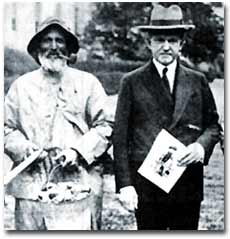
"Silent Cal" Coolidge, a man of few words, poses with a fisherman for a Massachusettes magazine
Despite all the verve of the American social scene in the 1920s, the Presidential leadership of the decade was quite unremarkable. WARREN HARDING won his bid for the White House in 1920 with the campaign slogan "RETURN TO NORMALCY." Republicans believed Americans had grown weary of the turmoil caused by World War I and promised tranquility. Harding found himself mired in scandals unknown in America since the Grant Administration. Although Harding himself was above the graft, his friends were more than willing to dip into the public treasury. Fraud and bribery plagued the Veterans Bureau and the Justice Department. TheTEAPOT DOME SCANDAL exposed Secretary of the Interior ALBERT FALL for accepting bribes for allowing private oil companies to lease public lands. Harding fell ill in 1923 and died shortly thereafter.
The Progressives
CALVIN COOLIDGE brought no significant change to Harding's laissez faire, pro-business style. Progressives bemoaned the end of activist Presidents protecting the public good, prompting FIGHTING BOB LAFOLLETTE to launch an unsuccessful run for the Presidency under the Progressive Party banner in 1924. The only successul progressive reforms occurred on the state and local levels. Politics became interesting in the election year of 1928. The Democrats nominated AL SMITH, the first Catholic ever to earn the nomination of a major party. Smith raised eyebrows with an open opposition to the Prohibition amendment. As a result, the South broke with a long tradition of supporting Democrats and helped Herbert Hoover to continue Republican domination of the Presidency.
The International Scene
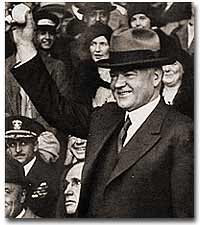
President Hoover tosses out the first pitch at a major league baseball game
On the international scene, two themes dominated American diplomacy. The first was to take steps to avoid the mistakes that led to World War I. To this end, President Harding convened theWASHINGTON NAVAL ARMS CONFERENCE in 1921. The United States, Great Britain, and Japan agreed to a ten-year freeze on the construction of battleships and to maintain a capital ship ratio of 5:5:3. They also agreed to uphold the OPEN DOOR POLICY and to respect each other's holdings in the Pacific. In 1928, the United States and France led an initiative called the KELLOGG-BRIAND PACT, in which 62 nations agreed to outlaw war. These two measures showed the degree to which Americans hoped to forestall another disastrous war. The second priority dealt with outstanding international debt. While practicing political isolation, the United States was completely entangled with Europe economically. The Allies owed the United States an enormous sum of money from World War I. Lacking the resources to reimburse America, the Allies relied on German reparations. The German economy was so debased by the Treaty of Versailles provisions that they relied on loans from American banks for support. In essence, American banks were funding the repayment of the foreign debt. As Germany slipped further and further into depression, the United States intervened again. The DAWES PLAN allowed Germany to extend their payments on more generous terms. In the end, when the GREAT DEPRESSION struck, only Finland was able to make good on its debt to the United States.
Darrow's Defense
The key to Clarence Darrow's defense strategy was to have scientists testify. On the trial's sixth day, JUDGE RAULSTON stated, "It is not within the province of the court under these issues to decide and determine which is true, the story of divine creation as taught in the Bible, or the story of the creation of man as taught by evolution." In short, no experts were needed to understand the simple language of the Butler law. Darrow's scientific experts were barred from testifying. By day's end, the sardonic Darrow had been charged with contempt of court.
The trial's seventh day featured charged exchanges between Darrow and Bryan, who was on the stand. But on the trial's eight day, Judge Raulston ruled that Bryan's testimony would not be allowed to stand on the record.
It was clear to Darrow that all was lost in this courtroom. In order to appeal the case to a higher court, Darrow asked the jury to find his client guilty. On July 21, 1925, it did.
It is interesting to speculate how history would have played out had Bryan been able to examine Darrow on the witness stand, which was Bryan's intention. But the trial concluded before Bryan had the chance.
Neither lawyer came out looking like a monkey.
The jury sided with the law. Clearly, Scopes was in violation of Tennessee statute by teaching that humans descended from monkeys. He was fined $100 and released. But the battle that played out before the nation proved a victory for supporters of evolutionary theory. A later court dismissed the fine imposed on Scopes, though in the short term, the antievolution law was upheld.
Fundamental Christians were down but not out. Through the radio airwaves, ministers such as BILLY SUNDAY reached audiences of thousands. AIMEE SEMPLE MCPHERSON of California preached her fundamentalist message over loudspeakers to arena-sized crowds. At one point, she used a giant electric sports scoreboard to illustrate the triumph of good over evil, foreshadowing generations of televangelists who would follow her lead.
Clearly, the 1920s did not see the end to these conflicts or the answers to their major questions.
